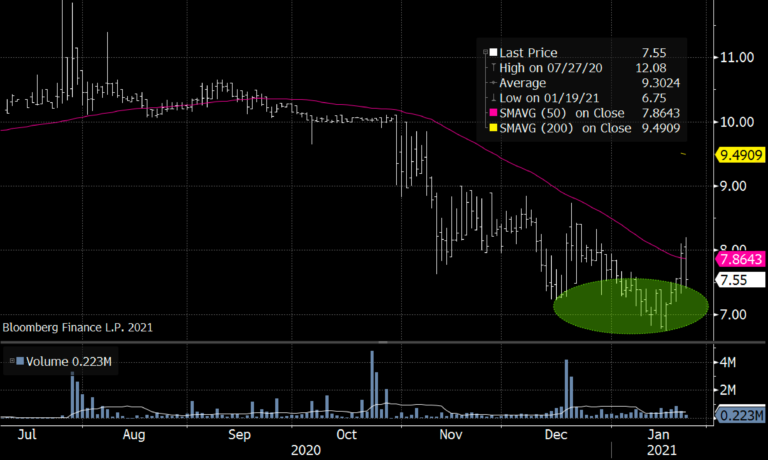Covid has catapulted remote medical care from an experimental lifeline serving rural communities, to a mainstream methodology strengthening national hospital systems, observes Adam Johnson, growth stock expert and editor of Bullseye Brief.
With thousands of would-be patients either too at-risk or too afraid to seek care in-person, expert consultation by video has become the new normal, super-charging primary care in the process.
US Department of Health and Human Services (HSS) recently took the unprecedented step waiving its right to enforce any potential HIPAA violations associated with video-technology, opting instead to expand reimbursement for video treatment… even adding audio-only communication as well.
This is staggering, effectively opening the floodgate for tele-medical practice at every level. My sense is that providers are overjoyed but unprepared. They have some significant procedural catching-up to do, especially since only three publicly traded telemedicine companies operate at a national scale. There’s a land grab going on, and I want my share.
SOC Telemed, Inc. (TLMD) is a newly-minted telemedicine company in the right place at the right time… the SOC stands for Specialist on Call. It’s one of just of three publicly traded providers linking patients and providers, though what sets Telemed apart is its focus on critical care.
The company specializes in connecting rural hospitals with nearly 200 experts at major medical centers during moment of acute risk… stroke, intensive care, and psychiatric trauma. If you’re suffering a stroke for example, Telemed gets you in front of a cardio-neurologist, and/or an ICU interventionist to determine immediate treatment protocol and follow-up.
The stock trades at one-third the valuation of peers and is growing 40-50% per year. I think it’s at least a triple, possibly more longer-term.
The telemedicine market is still in its infancy, having accelerated over the past twelve months in response to the distancing requirements associated with Covid.
While Teladoc (TDOC) is the headline-grabbing company we read about, and competitor American Well Corp. (AMWL) is coming up fast, I’m betting on much-smaller SOC Telemed because of its niche.
It’s more business to business than business to consumer, and the ramp-up can accelerate easily under new reimbursement protocols because wholesale hospital systems are the customer, not individuals.
Consider the difference. Teladoc connects patients to doctors and trades at 28 times sales. Telemed connects patients in rural emergency rooms to specialists at major medical centers and trades at 8 times sales.
Once a specialist has diagnosed a patient using SOC Telemed’s customized video set up — which transmits life-size images and all relevant vital stats on a fully mobile video cart — the local admitting hospital can then administer treatment, capturing all the fees that would previously have gone to a better-equipped city hospital following ambulatory evacuation.
In other words, Telemed helps rural hospitals fill their beds with patients and keep them there, generating thousands of incremental dollars per day. Telemed is effectively a profit center for these hospitals. Signing up Telemed generates revenue they wouldn’t otherwise have, and the payoff is virtually instantaneous.
SOC Telemed has significant opportunity to upsell to existing clients, which include 850 facilities at 18 of the top 25 health systems in the US.
The current addressable market for Telemed’s chosen suite of services (ICU, Neurology, Psychiatry) is $2.8B, versus revenues of just $75M. If the company simply increases usage of existing clients with existing services, it could recognize a thirty-fold increase in revenue.
That’s low hanging fruit, and well within reach given that 90% of health systems expect to increase clinician to clinician acute telemedicine services over the next 18-24 months, according to a recent study by Ernst & Young.
Telemed added 300 installations in 2020 and provided over 1,200,000 separate consultations… that’s nearly four per day. Admittedly, I’m surprised revenues aren’t higher, except that reimbursement has been slow to come. Now that HHS has enabled Medicare coverage, I expect an acceleration in revenue.
Again, SOC Telemed revenues are just $75M, despite serving 18 of the country’s 25 top health systems… with more ICU and stroke specialists on-call than any other provider.

Ironically, Telemed’s consultation volumes suffered initially during Covid’s onset because hospital visits declined, unlike volumes for TDOC which soared by enabling patients NOT to go the the hospital.
I think that’s why TLMD stock has languished in the single digits. SOC Telemed is an IN-HOSPITAL solution, not an in-your-home solution. The good news for us is that at the stock is still cheap, and volumes have since recovered, resuming their upward trajectory.
SOC Telemed trades at eight times sales, compared to 22 times for Teladoc and 30 times sales for American Well Corp. That’s a significant discount. With revenues also significantly smaller, and a stock price of less than $8/share, I see enormous potential upside.
Only four analysts cover the stock, and I think it’s simply not yet on enough radar screen. As more investors discover the company and embrace the potential upside for telemedicine, I think momentum alone could propel shares higher.





















